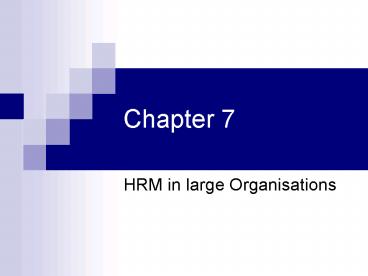HRM in large Organisations - PowerPoint PPT Presentation
1 / 18
Title:
HRM in large Organisations
Description:
Ppl manages need to monitor and control performance ... OT provides frame of reference and different viewpoints. ... Degree of bureaucracy. Organisational goals ... – PowerPoint PPT presentation
Number of Views:24
Avg rating:3.0/5.0
Title: HRM in large Organisations
1
Chapter 7
- HRM in large Organisations
2
Introduction
- Organisations are
- Social entities
- Common goals
- Unrestricted range
- Boundary
- Structure of relationships
- Recognised as entities but they are also
intangible.
3
Cont
- Ppl manages need to monitor and control
performance to achieve org goals - Need to manage ppl as well as corporate structure
and culture - OT provides frame of reference and different
viewpoints.
4
Organisations and the business environment
- Competition has increased
- Environmental norms and culture reflected in
organisations- influences structures - Different structures lead to diff ppl management
approaches - Businesses also control environmental elements in
order to survive. - HR moving away from employing inflexible ees to
range of other alternatives - Blind pursuit of cost effectiveness reduces ee
commitment.
5
Dimensions of organisation
- Decision to manage ppl in a particular way
depends on a number of factors - Organizational goals
- Size
- Small-to-medium enterprises (SMEs)
- Large commercial
- Public or state sector
- Cooperatives
6
Cont
- Managerial structures
- Coordination
- Specialization
- Centralization-decentralization
- Hierarchy
- Degree of bureaucracy
7
Organisational goals
- The logical starting point for HRm lies in an
organisations goals- the reasons for its
existence. Most modern businesse express these
goals in the form of a mission statement. The
allocation and control of human resources serves
to assist or constrain the achievement of these
objectives.
8
Coordination
- Tasks divided among a group of individuals must
be synchronised and integrated in some way as to
achieve the overall objectives of the group. Jobs
must fit into a coherent flow of work.
Coordination involves the distribution of
decisionmaking. This can be formal, with rigid
rules and regulations, or informal, giving
freedom for local decisions. Coordination may be
routine, because of structure and control
mechanisms, including a performance mgmt system
or direct, by mgmt action.
9
Specialisation
- The division of work btwn indvls or departments,
allocating responsibilities for specific
activities or functions to ppl who can achieve a
high standard of work in a relatively narrow
range of activities. They may require specific
training or expertise. For example, HR managers
are concerned with organisation of the HR
function and resourcing of all other functions.
10
Centralisation- decentralisation
- This depends on where decisions are taken. The
human resource function may be held within a
separate headquarters department or devolved to
local sections. Alternatively, it may be
allocated to line managers, with an in house
consultancy provided by specialists for
procedures such as selection, development and
performance measurement.
11
Hierarchy
- The structure by which individual responsibility
and authority is divided in an organisation,
usually represented by a tree and branch chart
and reflecting the percepttion of senior
managers. Vertical complexity is indicated by a
tall or flat hierarchy. Taller organisations
tend to be bureaucratic but have clear lines of
command. Each indvl has one boss. flatter orgs
are increasingly common. They demand more
responsibility and self- control from staff, but
decisionmaking and authority are less clear.
12
Organisational Structures
- Functional structures-org divided into defined
activities - Divisional structures-based on specific products
or ranges - Federations-loosely connected businesses with
single holding company - Matrix- focus on project teams
13
Cont
- New structures- more flexibility
- Networks- extend firms beyond their own
boundaries - Virtual orgs- project based, no physical offices.
14
Organisational strategies
- One best approach
- Contingent approaches
- Determined by major variable
- Or strategic choice
- Crisp structure
- Or flexible fuzzy structure
- Uniformity of organisations
- Attenuation
- decisionmaking
15
The HR role in large organisations
- Traditional personnel-type dept.
- In-house agencies
- Internal consultancies
- Business within a business
- External consultancies
- Outsourcing
16
Flexibility
- The concept covers a combination of practices
that enable organisations to react quickly and
cheaply to environmental changes. In essence,
flexibility is demanded from the workforce in
terms of pay, contractual rights, hours and
conditions, and working practices. This extends
to the employment market, requiring jobseekers to
show a willingness to move location, change
occupation and accept radically different terms
of employment.
17
Cont
- Numerical flexibility
- Functional flexibility
- Pay flexibility
- Core and peripheral workforce
18
(No Transcript)































